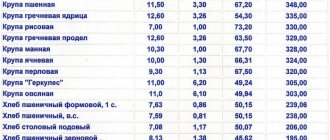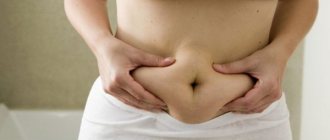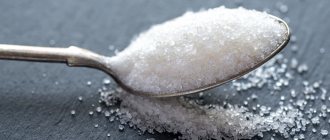according to his level?
The glycemic index (GI) shows how different foods change blood sugar. It compares the body's response to a certain product with its reaction to the consumption of glucose, its GI is 100. Other products have an index from 0 to 100 or more.
GI is not a constant value and depends on:
- Amount and type of carbohydrates;
- The presence or absence of fiber in the product;
- Method of heat treatment;
- Degree of fruit ripening.
There are products with:
- Low GI – no higher than 55;
- Average GI – 56-69;
- High GI – 70 and above.
High GI – in foods, after consumption of which the glucose level rises quickly. Di- and monosaccharides (sucrose, glucose, fructose) are quickly absorbed from the intestine and cause a rapid increase in blood carbohydrates - within 10 minutes after their consumption.
Such products:
- Does not contain fiber;
- They have a small volume;
- Poorly satisfy appetite;
- A short time after taking them, the feeling of hunger returns again, and the person overeats.
Low GI foods are slowly absorbed. They do not raise blood sugar much. Polysaccharides (starch and others) take a long time to break down in the intestines and therefore take longer to be absorbed. After taking them, an increase in glucose occurs after about 30 minutes.
The level of carbohydrates in the blood increases after each meal. However, during normal functioning of the body, their levels should return to normal in two to three hours. Sometimes a slight increase in fasting blood sugar can occur without diabetes, but is caused by pregnancy, inflammation, heart attack, or a large intake of carbohydrate foods the day before. However, any recorded episode of glucose growth must be further examined so as not to miss the onset of diabetes.
Tables of foods with GI
We offer a table with a list of foods that increase blood sugar.
High GI is found in:
| Name | Glycemic index |
| Wheat bread | 137 |
| Vermicelli | 135 |
| Beer drinks | 112 |
| Dates | 146 |
| Cookie | 107 |
| Beet | 99 |
| Flour cake | 101 |
| Potato | 95 |
| Pasta | 91 |
| Honey | 92 |
| Ice cream | 91 |
| Carrot | 85 |
| Chips | 81 |
| Common rice | 81 |
| Pumpkin | 75 |
| Milk chocolate | 75 |
| Dumplings | 70 |
Foods with medium GI:
| Name | Glycemic index |
| Flour | 70 |
| Wheat groats | 69 |
| Cereals | 67 |
| A pineapple | 67 |
| Boiled potatoes | 66 |
| Canned vegetables | 65 |
| Bananas | 64 |
| Semolina | 66 |
| Ripe melon | 66 |
| Raisin | 65 |
| Rice | 60 |
| Papaya | 58 |
| Oat cookies | 55 |
| Yogurt | 52 |
| Buckwheat | 50 |
| Kiwi | 50 |
| Fruit juices | 48 |
| Mango | 50 |
Low GI food products:
| Name | Glycemic index |
| Grape | 40 |
| Fresh peas | 40 |
| Apple juice | 40 |
| White beans | 40 |
| Grain bread | 40 |
| Dried apricots | 35 |
| Natural yogurt | 35 |
| Milk | 32 |
| Cabbage | 10 |
| Eggplant | 10 |
A table of foods that increase blood sugar will help you control your daily intake. Moreover, they can be replaced with healthy food.
Properties of foods with different glycemic index - desktop index table
Table 1. High index foods (easily digestible carbohydrates)
| Product | GI |
| Dried dates | 146 |
| Beer drinks | 110 |
| Shortbread | 106 |
| Boiled beets | 99 |
| Baked potato | 95 |
| Pasta | 90 |
| Mashed potatoes | 90 |
| Honey | 90 |
| Parboiled rice | 83 |
| Muesli with dried fruits and nuts | 80 |
| Potato chips | 80 |
| Sweet corn | 78 |
| Pumpkin | 75 |
| Sweet sparkling water | 70 |
| Boiled potatoes in their jackets | 65 |
| Semolina | 65 |
Products with a GI of 70-100 (mono- and disaccharides) are high-glycemic, they are:
- quickly absorbed and sharply increase blood sugar levels;
- Promote insulin production in a short time;
- Sharply increase energy, a surge of strength;
- Provide the body with carbohydrates for a short time, stimulate appetite;
- Increases the possibility of subcutaneous fat formation.
Table 2. Low index foods whose carbohydrates are complex (“good”)
| Product | GI |
| Apricots (fresh) | 30 |
| Pear | 30 |
| Carrots (raw) | 30 |
| Milk | 30 |
| Yogurt not flavored | 20 |
| Cherry | 20 |
| Eggplant | 20 |
| Mushrooms | 15 |
| Sweet pepper | 15 |
| cucumbers | 15 |
| Radish | 15 |
| Raw white cabbage | 15 |
| Leaf salad | 15 |
| Black currant | 15 |
| Olives | 15 |
| Seafood | 5 |
Products with a GI below 40 (fiber and polysaccharides) are low glycemic:
- Deliver carbohydrates throughout the day, gradually increasing their levels in the blood;
- Slightly increase insulin levels;
- Reduces the load on the pancreas;
- Prevent obesity and diabetes;
- Provides a feeling of fullness;
- Ineffective during physical activity.
When using fruits and vegetables in your diet, you need to take their GI into account. Some of them can also increase sugar.
Fruits and vegetables that are very common in Russia have a high GI:
- Boiled beets – 99;
- Boiled, baked, fried potatoes – 95;
- Boiled carrots – 85;
- Raisins – 65;
- Bananas – 60.
How to use the GI table
The diet of diabetics is compiled taking into account the glycemic index (GI) of foods. This indicator helps to understand how quickly glucose enters the blood after eating food. The higher its value, the higher the risk of developing hyperglycemia.
For people with diabetes, the ideal diet includes foods with a GI below 30. Intake of food with a glycemic index level of 30 to 70 should be strictly controlled.
It is recommended to completely exclude food with an index of more than 70 units from the menu. GI table for products
| Products | Name | GI values |
| Berries, fruits | Persimmon | 50 |
| Kiwi | 50 | |
| Banana | 60 | |
| A pineapple | 66 | |
| Watermelon | 75 | |
| Dates | 103 | |
| Cereals | Cereals | 60 |
| Pearl barley | 70 | |
| Millet | 70 | |
| Millet | 70 | |
| Brown rice | 79 | |
| Parboiled rice | 83 | |
| Rice porrige | 90 | |
| Pasta | 90 | |
| Corn flakes | 95 | |
| Bakery products | Black yeast bread | 65 |
| Butter buns | 95 | |
| Wheat toast | 100 | |
| Wheat bagel | 103 | |
| Sweets | Marmalade | 65 |
| Sweet soda | 70 | |
| Croissant | 70 | |
| Dry biscuit | 70 | |
| Milk chocolate | 70 | |
| Unsweetened waffles | 76 | |
| Cracker | 80 | |
| Ice cream | 87 | |
| Honey | 90 | |
| Vegetables | Beetroot (raw) | 30 |
| Carrots (raw) | 35 | |
| Melon | 60 | |
| Beetroot (boiled) | 65 | |
| Pumpkin | 75 | |
| Beans | 80 | |
| Carrots (boiled) | 85 | |
| Mashed potatoes | 90 | |
| Baked potato | 95 |
The table below is useful not only for patients with type 1 or type 2 diabetes. It can be used by women diagnosed with the gestational form of the disease. This data is also needed by people who are prone to diabetes.
The myth about foods that lower blood sugar
Contrary to the claims of the advertising gods, you cannot eat anything to reduce the level of carbohydrates in the blood. Any food increases sugar levels. A slower rise and lower glucose levels can be achieved by eating low GI foods containing fiber.
The GI of dishes also depends on the composition of the products, methods of preparation and order of intake:
- Products containing starch increase their GI when heated.
- Crushing foods increases their GI, because this way they are digested and absorbed faster.
- The GI will decrease if you add vegetable oil. It slows down digestion and absorption of carbohydrates.
- The absorption of glucose is also affected by the sequence of food intake: it is better to take foods with “slow” sugars at the beginning of a meal (porridge, meat, fish, salads), so that the “fast” carbohydrates (sweets) taken after them are absorbed more slowly. This simple trick significantly slows down the growth of glucose in the blood.
The fiber myth
There is an idea that dietary fiber lowers blood glucose. However, fiber is practically not absorbed by the body. The sugar level when taking such products is lower because its absorption slows down. Fiber-rich foods contain vitamins and water, which has no calories. It simply fills the stomach and creates a feeling of fullness. Therefore, the presence of dietary fiber and fiber in the diet prevents the rapid absorption of sugar and keeps it at a low level.
Fiber and plant fibers are found in:
- Greenery;
- Vegetables;
- Berries;
- Some fruits;
- Krupach;
- Products made from wholemeal flour.
Facts about GI in different foods
- Dairy products are the basis of nutrition for the majority of the population. Their GI is 15-80. Those containing sugar have a higher index.
- Flour products have a GI of 35-100. Its level is affected by food additives: raising agents, sweeteners, flavor enhancers.
- GI of grain products – 20-90. They are low in fat. Carbohydrates in cereals are polysaccharides, which slowly increase blood glucose. GI levels in grain products are also affected by added sugar.
- GI of confectionery products – 20-90. The high index of most of them is also associated with the presence of sugar. They should be consumed after a meal that slows down digestion and preferably before 14:00.
- Vegetables reduce the GI of food, slowing down the absorption of carbohydrates and the speed of digestion.
- Fruits that contain dietary fiber reduce GI.
- Soft drinks have a GI of 15-110. For most, it is high due to sugar, and carbonation further increases the absorption of carbohydrates.
- Products containing fat (oils and sauces) have a GI of 15-60. It is better to use vegetable oils. They have the lowest GI.
- The GI of nuts is 8-30, they contain a lot of fat and are difficult to digest.
How to organize a complete and healthy diet
A comparison chart of low and high GI foods will help you determine which foods raise your blood sugar and which do not. Most components with a high glycemic index can be replaced with tasty and healthy ones with values up to 70 . In this way, a person can prepare a proper and safe diet.
| High GI foods | GI | Low GI foods | GI |
| Dates | 103 | Raisin | 64 |
| A pineapple | 64 | Dried apricots | 35 |
| Banana | 60 | Grape | 40 |
| Baked potato | 95 | Boiled potatoes | 65 |
| Boiled carrots | 85 | Raw carrots | 35 |
| Pumpkin | 75 | Raw beets | 30 |
| Grain bread | 90 | Black yeast bread | 65 |
| Pasta | 90 | Rice | 60 |
| Honey | 90 | Apple juice | 40 |
| Canned fruits | 92 | Fresh apricots | 20 |
| Ice cream | 80 | Natural yogurt | 35 |
| Chips | 80 | Walnuts | 15 |
| Zucchini | 75 | Eggplant | 10 |
| White beans | 40 | Mushrooms | 10 |
| broad beans | 80 | Cabbage | 10 |
| Chocolate | 70 | Black chocolate | 22 |
| Oat cookies | 55 | Sunflower seeds | 8 |
| Mango | 50 | Cherry | 25 |
| Papaya | 58 | Grapefruit | 22 |
Products with high blood sugar should contain many vitamins and few carbohydrates. It is recommended to consume them fresh, as this preserves more vitamins and nutrients.
For many patients, a diabetes diet is the only solution. If you do not control the daily amount of sugar consumed, serious consequences can occur.
There are a large number of foods with a low glycemic index . Therefore, the diet of patients with diabetes can be developed in such a way that it contains all the necessary nutrients, is nutritious and balanced.
Based on medical experience, I can say that diet helps many people live freely with diabetes. You just need to get tested regularly and monitor all indicators. If you exceed the norm, be sure to consult a doctor.
In addition, we suggest watching a video about foods that are contraindicated for diabetics:
Useful advice from nutritionists
How to avoid excessive increase in blood carbohydrates:
- If you have an irresistible need to eat sweets, try sugar substitutes.
- Avoid candy, especially hard candy. Use marshmallows and marmalade.
- Fill your diet with complex carbohydrates. With slow absorption of glucose, the performance of the pancreas increases.
- You need to eat: whole grain cereals (buckwheat, barley, oatmeal, barley, brown rice); bran; foods containing fiber, which slow down the absorption of sugar; a lot of natural vegetables (up to 2/3 of the daily diet).
- When eating fruits, you need to pay attention to their GI. It is better not to overuse dried fruits, bananas, apricots, grapes and eat them not on an empty stomach, but after the main meal.
- Reduce the amount of animal fats you eat; they need to be replaced with vegetable ones.
- Instead of regular cheese, you can sometimes eat tofu, and occasionally replace the usual milk with almond, soy, rice or coconut.
- Choose lean meats - veal, chicken breast, turkey. When cooking poultry, remove the skin.
- The most healthy dishes are steamed, fresh, baked, boiled. During cooking, replace animal fat with vegetable fat.
- Recommended foods : legumes, cabbage.
- Among the berries, blueberries are prized. It can reduce blood glucose, stimulate insulin secretion and normalize the activity of the pancreas.
- Doctors advise using garlic, onions, celery, herbs, vegetable smoothies and fresh juices in your diet.
- Coffee lovers should change their drink to chicory. Instead of black tea, it is better to drink herbal or green tea.
- You need to eat food often (at least 5 times a day) and in small portions. This way you will protect the pancreas from overload.
- Fasting will lower your blood sugar and increase hunger, but will not be beneficial.
- Do not eat at the computer or in front of the TV - you will definitely eat too much while being distracted by watching programs.
- When preparing food, people often eat full portions - don't forget about it.
- If you feel acute hunger, try to control yourself. To begin with, you can eat something light and low-calorie - an apple, lettuce, a slice of pineapple, drink tea with lemon.
- Avoid stress that leads to overeating.
- Spend a lot of time in nature.
- Monitor your blood sugar using a portable glucose meter. Monitor your blood pressure.











